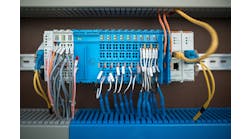As early project visioning shifts into more detailed engineering, it's time to take a much closer look at how the latest automation technology and project execution methodologies can be brought to bear for project success. Key automation considerations at this stage include evaluating those technologies that will reduce project costs and schedule risk, as well as those that will enable improved plant performance once operations takes over. As it happens, some key technology decisions can advance the cause on both counts. And the global project services team from Emerson can guide you on the path—and help execute the details, too.
In particular, virtualization, simulation, Electronic Marshalling, and wireless networking are among the proven technologies that can have a dramatic positive impact on project cost and schedule, while contributing to more efficient and flexible ongoing operations as well.
Collaboration technology provides access to global experts
In order to facilitate collaboration, Emerson developed its Remote Virtualization Office platform based on insights gained through the company's Project Management Office. This platform enables remote engineering, connecting Emerson's global team of project engineers and subject matter experts, clients, and other stakeholders throughout the project execution process.
The Remote Virtual Office platform provides an integrated engineering environment where project members can collaborate on engineering systems and tools. Data management tools exchange plant data between the Emerson integrated project database and engineering design packages such as SmartPlant Instrumentation. From the integrated project database, the base layer for the control system application is created automatically. Further, control system loop diagrams and other project documentation can be generated automatically, negating the time consuming and error prone manual exchange of data. Project engineers have access to libraries of proven application code that go beyond standard function blocks and provide optimal control for many devices, for example, variable speed drives. Emerson engineers maintain client-specific libraries for re-use on the client's projects around the globe. This further speeds design execution, minimizes potential errors, and makes for more consistent, supportable systems down the road.
During the recent construction of a state-of-the-art biopharma facility in southeast Asia, the depth of the global project services team that Emerson was able to bring to bear proved particularly critical. Due to an unanticipated project delay, the drugmaker had a limited, eight-month window to advance from the functional specification its own engineers had completed to a fully realized automation system design.
"We brought Emerson on early, and were able to leverage their process expertise and their understanding of their systems," said the automation specialist responsible for the plant design. "And when we needed to move quickly, Emerson ramped up people in multiple locations around the world." Indeed, as many as 65 people from 10 Emerson locations in Europe, Asia and the Americas were engaged on the project, which currently is being put through its final pre-start-up paces. "Who else but Emerson could do this?" he asks.
Projects move faster with hardware, software development decoupled
In addition to facilitating global collaboration among project team members, the Remote Virtual Office platform offers the ability to fully virtualize DeltaV control system servers, controllers and the Electronically Marshalled or traditional I/O; a detailed system design and configuration can be fully developed and tested on the fly, independent of its ultimate hardware implementation.
Clients also have access to the Remote Virtual Office, so when it comes time for the FAT, they can do a virtual FAT, or VFAT, from the comfort of their own office. "You can run through all the things you normally would in a FAT, without any control or I/O hardware at all," explains Peter Zornio, chief strategic officer, Emerson Process Management.
Meanwhile, the latest controller, server and operator station hardware, together with field enclosures or remote I/O cabinets with CHARMs technology, are shipped directly to the site. The junction boxes can be shipped to the plant before configuration is done, and ahead of the controllers, servers, and workstations. This is possible because with Electronic Marshalling, I/O hardware design specifics are no longer beholden to a final process design. An approximate total I/O count, irrespective of type, is all that's needed. Each and every channel is fully characterized by its respective CHARM plug-in, which can be added or changed even up to the last minute without impacting the overall hardware design. "You can plug in the characterization modules (CHARMs), download the pre-tested configurations and you're off and running," Zornio adds.
Even after the project is complete, virtualization continues to deliver low-risk system maintenance benefits at the server and workstation level, effectively decoupling the technology upgrade cycles of one's hardware and software.
Wireless makes added insights viable
Wireless provides the ultimate in installed instrument cost savings, and in a growing number of greenfield projects users are opting to include a WirelessHART-based instrument network infrastructure from the very beginning. Further, a WiFi-based wireless plant network for enabling Mobile Worker applications can make for much faster instrument commissioning and loop-checking during a project's final stages, effectively doubling the productivity of field technicians. Emerson project consultants can help identify the best solution for your needs and justify either or both types of wireless network investment, and, in the case of instrumentation, help determine which measurement points are clear candidates for wireless savings—and which are best left physically connected. Either way, early in the design cycle is the time to decide if wireless makes sense within the specifics of your particular project.
Of course, not all engineering and design decisions that need to be made hinge on the latest technology advances. Because of its depth of application experience and breadth of product portfolio, automation experts within Emerson's project services group also can answer more prosaic questions that nevertheless impact project risk and ongoing operations, such as "Which flowmeter technology is best suited for this particular application?"



